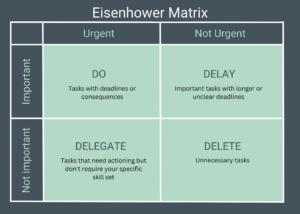You might be familiar with the Eisenhower Matrix, it’s a quick and effective tool that’s commonly used to help you prioritise tasks.
Traditional prioritisation using the Eisenhower Matrix
The approach was used by Eisenhower, the 34th President of the US, and repopularised more recently in Steven Covey’s book The 7 Habits of Highly Effective People. There are a few variations out there, but essentially the matrix works by assigning importance and urgency to a task, resulting in four actions – DO, DELAY, DELEGATE or DELETE.

Upgrading the Eisenhower approach for today
So this approach works great when you consider a non-digital workforce, as any particular task is going to have to be done by somebody. However, these days the question has to be asked – “should that task even be done by a human?”. If it’s a simple filing activity, is there a way to automate that task out of the workflow entirely?
Example – filing attachments from emails
You get an email from a client, and it includes the drawings for the project you need to create a brief for. The drawings need to be filed into the project folder. A simple task, but urgent, so it’s a good one to delegate to a junior admin resource. However, it’s possible these days to set up an automation so that when emails come in from a particular client, any attachments are automatically filed to the correct job folder. But, if you delegate this task to the junior admin, they don’t have the skillset or the authority to then automate. They’ll be manually downloading, creating folders and uploading documents until they’re told otherwise.
Whose call is it?
It’s easy to fall into the trap that an organisation needs more admin power as it increases in size or activity. As more work arrives on the desk of senior workers, it seems efficient to move less valuable tasks down the line, allowing more time for higher value work. The lower down the organisation these tasks travel, the less likely it is they will ever be automated. This is because the delegated person is not in a position to make the decision to automate. In the short term it is faster to delegate work, but by taking the time to understand the task that’s being passed on, and thinking about how all or parts of it might be automated, we can make an organisation more productive.
Delegate or Automate?
Maybe your career is benefitted by building the headcount that is reporting to you. In which case, delegate away! However, if you are working to build a lean organisation, with the minimum headcount for the maximum outcome, then it is necessary to seriously consider every delegation and ask the question, can that task be automated out? Research productivity tools like Zapier, and build the skillset within the organisation to create and maintain the required automations.
Better for clients
As an organisation we are becoming more productive by the day. We previously ran at a ratio of 1:6 for administrative support; we now run at 1:10 through automation and there’s more work to be done here. These increases in productivity have enabled us to provide more value in our service, which inevitably benefits our clients.
Understanding Seismic Assessment of existing Non-Structural Elements in Commercial Interiors
In the latest installment of Team Brevity's technical webinar series, we delved into the critical topic of seismic…
BALANCING SECURITY AND SEISMIC SAFETY: INTERIOR ENGINEERING FOR WAIKERIA PRISON
Brevity was engaged to provide the interior seismic engineering plans for the ceilings and partitions for the new…
SEISMIC DESIGN FOR RACKING AND SHELVING IN NEW ZEALAND
In the event of an earthquake, the seismic design of racking aims to reduce the risk of collapse or damage to the…


